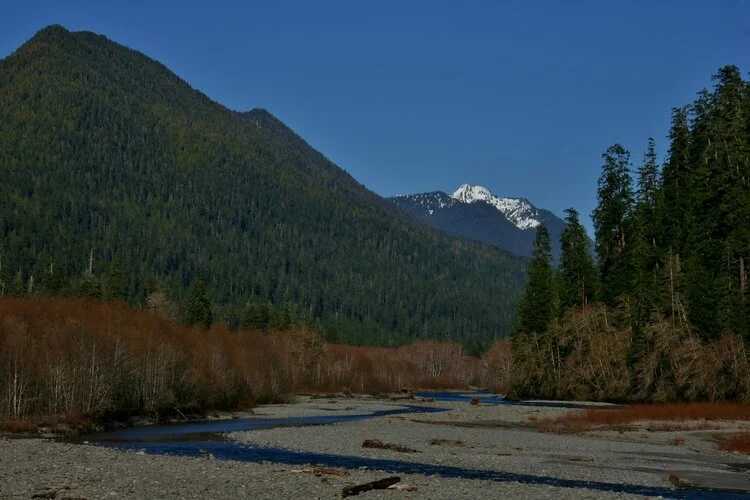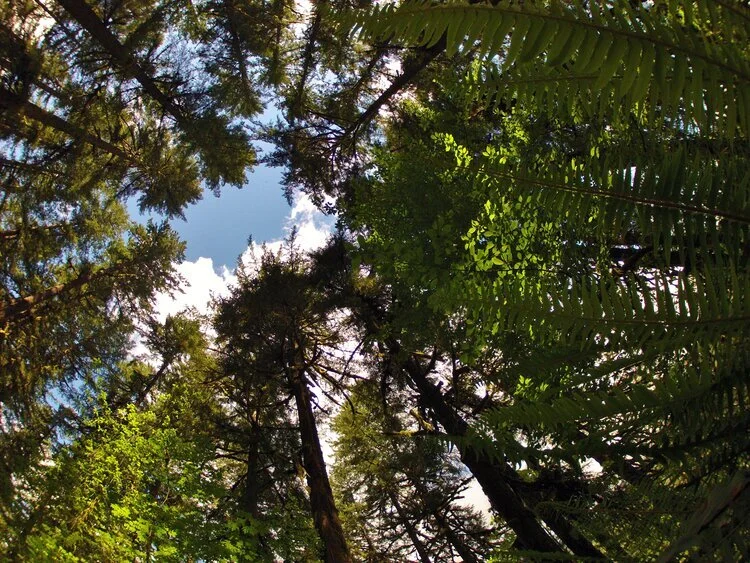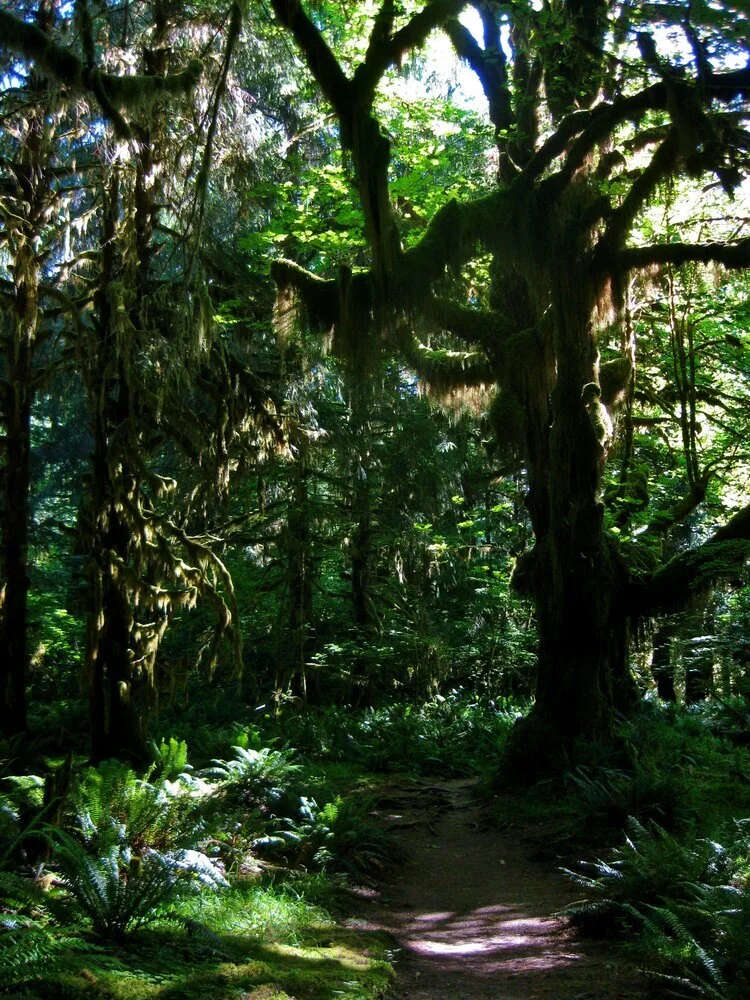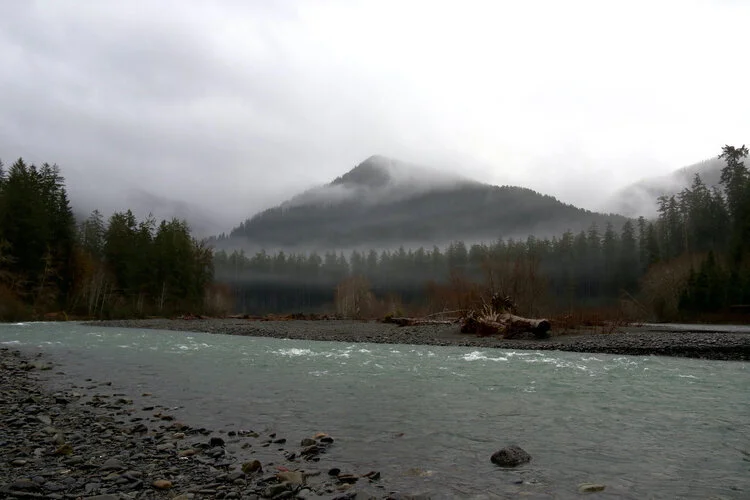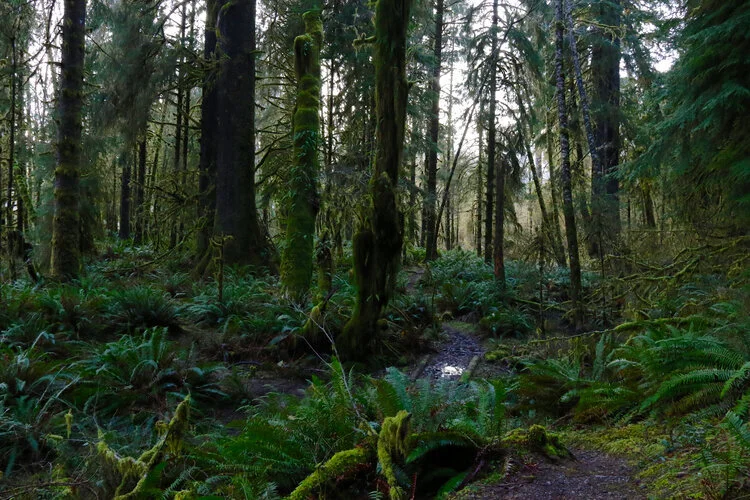Olympic Peninsula
THE FOUR RAINFOREST REGIONS
Photo Courtesy: Susan Flynn
Along the western side of the Olympic Peninsula, where storms roll off the Pacific Ocean and get stacked up against the rugged glaciated peaks, you’ll find Washington’s temperate rainforests. While the whole region is pretty much a rainforest, there are four main river valleys, lined with towering timbers, fields of ferns and serene rivers, that have been untouched, each giving a unique and wild experience. All accessible from Highway 101, the four stunning destinations help give you the ultimate wilderness adventure around Olympic National Park and Forest. Whether you choose one or explore all of them, this will help you have the best time in each area, no matter what the season.
Quinault
About an hour north of the twin timber towns of Aberdeen and Hoquiam, you’ll find the Quinault Rainforest. What makes the Quinault so great is that you can explore it on foot, or by your camper van by following a 34-mile long Quinault Loop Drive. Because of this, the Quinault is a favorite for locals and tourists alike. The Quinault rainforest is on Quinault Tribal lands, as well as in Olympic National Park and Olympic National Forest and gives direct access to world record sized trees, breathtaking waterfalls and endless ferns.
Once you have settled into camp, the exploration of the Quinault region is seemingly endless. In the spring, when the winter snows are melting, the river runs high as wildflowers burst through the greens with flashes of white, pink and yellow. Elk and eagles are occasionally spotted, as are black bear emerging from their state of torpor. The best spring hikes are the Maple Glade Trail on the north side of the lake, and Pony Bridge out of Graves Creek Campground.
As summer hits, the river starts to drop and the rainforest dries out a bit. The greens during summer are a little less vivid, but the ground is firm and the recreation opportunities are endless. You may still see a few elk and eagles, but bear sightings are less common. In the summer, the best hike to take is the Colonel Bob hike, as it climbs above the rainforest, giving you an unrivaled view of the entire rainforest. During the summer, you can also rent boats at the Lake Quinault Lodge to explore the lake.
Once the rain returns for the fall and winter, the rainforest earns its name, as feet of rain falls. The fresh rain brings back the salmon, as well as the eagles and the greens of the forest become extremely brilliant. The maples throughout the forest turn colors, as the sound of elk bugles passes over the ferns and mushrooms. As daylight hours dwindle, the rain arrives in full force. On these days, the Quinault Rainforest Nature Trail near the Lake Quinault Lodge and the Maple Glade Trail on the north side of the lake are perfect.
The Quinault Rainforest is a bit removed from most of the expected amenities, but general supplies can be picked up at Amanda Park and at Quinault Mercantile near the Lake Quinault Lodge. For larger chain stores, you’ll need to head to Aberdeen or Port Angeles.
CAMPING OPTIONS IN THE QUINAULT
To best experience the Quinault, a stay at one of the area’s five front country campgrounds is in order. The most remote and least used is the North Fork Campground in Olympic National Park. This is nice and rustic, as you’ll have a pit toilet and maybe running water and be right next to the North Fork of the Quinault River. Graves Creek, also in Olympic National Park, is a fantastic place to camp. It is about 30 minutes drive away from the amenities at Lake Quinault, right along the river, inside the old growth rainforest.
Queets
North of the coastal highlights of Olympic National Park’s Kalaloch area, you’ll find the Queets Rainforest. Overlooked by nearly every visitor to the Olympic Peninsula, the Queets is know for being truly remote and wild. Few places in any National Park feel as removed from society as the Queets, which is one of many reasons why you should visit it. Unlike the more well-known rainforest regions of Olympic, you’ll find zero amenities along the Queets.
To reach the Queets Rainforest, you’ll need to take the Upper Queets Road, between Amanda Park and the small town of Queets. There is a store and gas in Queets, but expect to be able to grab minimal supplies. There are also small stores at Kalaloch and Amanda Park, but once again, the larger stores will be found in Forks and Aberdeen.
CAMPING OPTIONS IN THE QUEETS
Once you have stocked up on supplies, head to the only campground in the Queets Rainforest, the aptly named Queets Campground. This campground is super remote and rarely visited by any of the three million visitors to Olympic National Park each year. You’ll only have a dozen or so sites to choose from, and no access to potable water, but this camping area is impossibly gorgeous. Located right near the Queets River, hiking trails and a huge spruce tree, pulling up to camp here is an incredibly underrated experience and one that you will enjoy any time of the year.
In the fall and winter months, expect constant and occasional heavy rains in the Queets Rainforest. Known for huge trees, endless ferns and pure, uninterrupted wilderness, seeing this area in the rain is for the heartiest explorers. If you do find yourself here after September, expect to see elk in the forest and salmon and eagles along the riverbanks. Once April starts, the weather gets better and the forest explodes with wildflowers and mushrooms, as well as numerous bear sightings. Campers here have to be extremely diligent about cleaning up camp, as bears are quite common in the Queets. In these three seasons, those hoping for a hike will have one main trail option, the three mile Sam’s River Loop Trail. Along this hike, you’ll encounter one of the most pristine old growth trails on the Olympic Peninsula.
Once summer starts, the Queets Rainforest gets a little more crowded, but nothing compared to the Quinault or Hoh Rainforests. You’ll have access to the old growth forests and even have potential bear sightings without as much rain, but that isn’t the only perk of visiting in the summer. Once the Queets River drops down to a small flow, adventurous hikers can wade across the river and then hike along the Queets River Trail. This is one of the least hiked trails in Olympic and is full of the silence, beauty and the impossibly green hues for which you are searching. With trails like these and gigantic trees all around, the Queets Rainforest is as pure of wilderness as you will find anywhere in the contiguous United States. Therefore, it should not be missed.
Hoh
Fifteen minutes south of the town of Forks, where all the amenities you’ll need can be picked up, you’ll find two access points into the world renowned Hoh Rainforest. Each section is unique, granting a different rainforest experience. Those looking for the classic Hoh Rainforest views- dripping moss, well-maintained trails, river access and a paved and scenic road- will want to take the Upper Hoh Road. You’ll find small stores, towering trees and scenic views along this road, as well as entrance to Olympic National Park. You’ll also more than likely see elk, deer and eagles throughout the year, as this is a great spot for wildlife watching. In November, returning salmon fill the small creeks, making this a can’t miss destination. During the salmon run, you may even see bobcats along the shore, fishing for a good meal. The fall will also yield some fall colors in the maple trees around the region.
Once you are in the main access point to the Hoh Rainforest, you have a few adventure options to choose from. Keep in mind that during the summer months, this area of the Hoh can be a bit crowded, as it is the 4th most-visited area in Olympic National Park. The two classic hikes in the Hoh are the Hall of Mosses Trail and the Spruce Nature Trail. Both hike should be done, as you’ll pass through a maple grove that has trees weighed down by hundreds of pounds of moss, over creeks full of green grasses drifting in the current, and past fallen giants giving life to future generations of rainforest. Another hike along the Hoh River Trail leads all the way to the glaciers of Mount Olympus, 20 miles away. However, one of the hidden gems in the Hoh, Mineral Creek Falls, is just 2.5 miles from the visitor center along this same trail.
Those hoping for something off the main tourist path should head south, over the Hoh River and follow H-1000 to the South Fork of the Hoh. Here, you’ll leave the paved comforts and follow a gravel road to this remote region. Along the South Fork of the Hoh, you have both camping and hiking options. The only campground here is the South Fork Campground operated by the Washington Department of Natural Resources. This primitive campground is in the woods and a short jaunt from the overlooked South Fork Hoh Trail. At 4.2 miles in length, the trail isn’t as well-known as the hikes on the main fork of the Hoh River. What the South Fork lacks in recognition, the camping and hiking make up for in wilderness beauty.
CAMPING OPTIONS IN THE HOH
Along the Upper Hoh Road, you’ll find two camping options. The first is outside of the park, in the Minnie Peterson Campground, placed in a second growth forest on Department of Natural Resources land. With just nine campsites available, this minimal amenity campground is open all year and is a nice option if the main campground in the park is full. The campground inside the park is a full National Park camping area, with 88 sites, running water and flushing toilets. Located right along the river, this campsite is one of the most scenic places to camp on the Peninsula.
Bogachiel
Found just a few miles southeast of the town of Forks, the Bogachiel Rainforest is another of the overlooked regions on the Olympic Peninsula. A local favorite, the Bogachiel is best seen on foot. This entire region is breathtaking and is just a short drive to reach the Bogachiel Rainforest. Keep in mind that the drive to the rainforest isn’t as scenic as it could be, since the majority of the route has been logged in the last 35 years.
After finding a great place to camp, exploring the Bogachiel is simple, as there is really just one main way most enter this breathtaking forest. A few miles south of Forks and across from Bogachiel State Park, you’ll find Undine Road. Like all the entrances to the rainforests, except the main entrance to the Hoh, this road is both paved and gravel. Once you reach the end, the only way to enter the Bogachiel is to get out and hike. Year round, there are three trails of varying length to explore. Those looking for a longer hike can walk the Bogachiel Rainforest Trail, which is also part of the 1,200 mile Pacific Northwest Trail. Most who hike this will go out three to six miles, entering the most stunning and accessible stretches of this rainforest river valley. If that seems too long, the Ira Spring Wetland Trail and the Homestead Loop hikes are much shorter and give the perfect taste of what the Bogachiel is all about. With elk roaming amongst the ferns and eagles fishing along the river, the Bogachiel is a fantastic entry to the wilderness you’ll find all around the Olympic Peninsula.
The nearest amenities around the Bogachiel can be found in Forks. With restaurants, museums, shops, gas stations and a grocery, nearly everything you need can be found here. If you can’t find it in Forks, you are an hour from the much larger city of Port Angeles. An added bonus to staying near the Bogachiel is that you’ll also be close to both the wild Olympic Coast and a short drive to the aforementioned Hoh Rainforest.
What makes the Olympic Peninsula so great is that you can, and should, stop and visit all of these rainforest river valleys when visiting the region. Easy to get to and always scenic, a stop for an afternoon or for a few days will reward you with unrivaled wilderness, towering trees and a memorable trip into America’s favorite temperate rainforest. For more tips on exploring the Olympic Peninsula, consider picking up an Olympic guidebook written by the author of this post.
CAMPING OPTIONS IN THE BOGACHIEL
Luckily, the bogachiel is close to two camping areas- dispersed camping near the old Klahanie Campground, operated by the United States Forest Service, and Bogachiel State Park, operated by Washington State Parks. The State Park option is a front country feeling campground, with the standard amenities you expect to find at a well used campground. The dispersed camping found along Forest Road 29, where Klahanie Campground used to be, is more rustic, surrounded by an old growth forest with hanging mosses and sword ferns everywhere. The campground closed in 2018 and it may reopen in the future, but for now just find a place to stay off the road.


